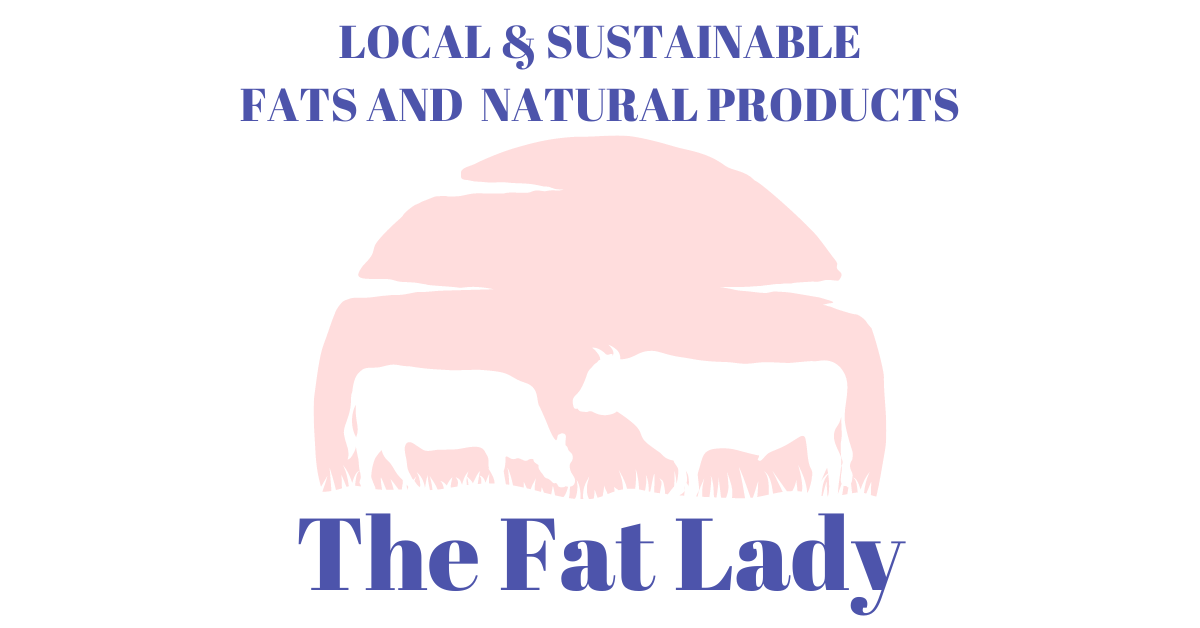FAQs – Grass-Fed Beef Tallow Uses, Shipping & Safety Info
What is tallow?
Tallow is a rendered fat, primarily made from beef or mutton fat around the kidneys, used in cooking, soap making, skincare, candle making, and lubricants. This is one of our most popular items. Our grass-fed and grass-finished beef tallow is perfect for everyday use—exceptional quality and choice.
How is your tallow made?
The Fat Lady sources 100% grass-fed beef from small, sustainable farms in Wisconsin and the surrounding areas. We take pride in offering tallow and lard that are minimally processed and USDA-inspected. Unlike many tallow companies, we often purchase entire healthy, high-quality animals rather than just the fat.
Our tallow is rendered using a traditional dry method that requires no water to transform raw beef fat (usually suet) into golden, shelf-stable tallow. In contrast to wet rendering, which uses water to buffer the fat, our dry rendering method relies on low, slow heat. This gentle process melts the fat and separates it from any connective tissue or impurities.
Over the past seven years, we have continuously improved our method, finding that it better preserves the nutrients and fat profiles for a wide range of applications and uses. We don't homogenize, bleach, or deodorize our fats. The end product may vary from batch to batch, depending on the nature of what is provided.
What is "Soft" tallow?
We call Soft Tallow our grass-fed and grass-finished beef rendered Back Trim Fat. We use the same artisanal dry rendering proven method to render our regular tallow. It is softer than our regular tallow and melts very quickly, similar to Coconut Oil. This fat type can replace liquid or seed oils in Skin Care formulations, whipped tallow, and cooking.
What are the uses of tallow?
Our grass-fed beef tallow can be used in various applications, including cooking (as a substitute for butter or oil), producing soap, creams, and candles, as a lubricant in industry, and some traditional medicines. It can also be used to polish wood and season cast iron pots.
Please also note that our pure tallow usually has a medium-hard texture, not too soft, but it melts very quickly.
Is Tallow healthy?
The healthiness of tallow can depend on the context of an individual's diet and health. Tallow is high in saturated fats, which some dietary guidelines recommend limiting. However, it also contains monounsaturated fats and is used in some culinary traditions as a preferred source of fat. Tallow is an excellent choice for skincare because it contains a wide range of highly beneficial nutrients that are beneficial to the skin.
Can tallow be used in vegetarian or vegan diets?
No, tallow is animal-derived and unsuitable for vegetarian or vegan diets.
How should tallow be stored?
Tallow should be stored in a cool, dark place, preferably at a temperature of 70 degrees Fahrenheit or below. It can be kept at room temperature, but refrigeration can extend its shelf life for 1-2 years. Contact with water must be avoided; otherwise, mold can grow.
If you buy a large, fat container, keep some in a glass container for daily use and refrigerate the rest.
Why is my tallow grainy?
Due to temperature sensitivity, a Tallow made from 100% suet can become grainy or crystallize. When heated, tallow, a solid ingredient, turns into a liquid, and upon cooling, it separates into fats and liquid. It can develop a grainy texture if it doesn't cool properly or undergoes multiple heating and cooling cycles in less-than-ideal conditions, such as during summer.
To stabilize grainy or soft tallow made from suet, and as a general recommendation to improve the consistency of whipped tallow, you can reheat it to ~200°F (the High setting in the crockpot is recommended) and hold it at that temperature for 4 to 6 hours. Then, leave it in a crock pot at a warm temperature (150–160°F) for 4-6 hours.
What is the difference between tallow and lard?
Tallow is rendered fat from beef or mutton, while lard is rendered fat from pigs. They have different flavor profiles and uses in cooking and other applications.
Can tallow be used in all types of cooking?
Tallow is a versatile ingredient that can be used for frying, roasting, and baking. However, its flavor may only be suitable for some dishes. Additionally, consistency may vary depending on the season and batch. Sometimes, the fat is hard, while other times, it is softer. We don't homogenize, bleach, or deodorize it. The end product may vary from batch to batch, depending on the nature of what is provided.
How can tallow become odorless or harder?
To thoroughly deodorize tallow, it must be wet rendered, which has some benefits and challenges. You can wet render our tallow to meet your specific needs. Here you can find a quick tutorial video on how to wet render tallow.
Our premium beef tallow is derived from grass-fed and grass-finished cattle. We do not deodorize or add artificial scents, making it ideal for cooking. This fat is unadulterated and maintains its natural fat constituents, making it perfect for creating skincare products (this has been the experience of many of our clients, as well as ours). Although it has a mild natural beefy scent, it undergoes thorough dry-rendering and double-filtering to ensure maximum purity. Some people may not like the smell, so you can add essential oils or herbs (We recommend Mountain Rose Herbs) to mask it. (It takes a few days to curate).
We also recommend following these sustainable and safe practices when using essential oils.
We have also found that following the same process to stabilize tallow when it is grainy can significantly reduce the scent. See "Why is my tallow grainy?"
We ask our customers to contact us for returns or to consider exchanging the product they received for one of our skin therapeutic balms if the product doesn't meet their expectations.
How are whipped tallow and skincare creams made?
Visit www.thefatladytallow.com/recipes, for recipes and basic formulations.

